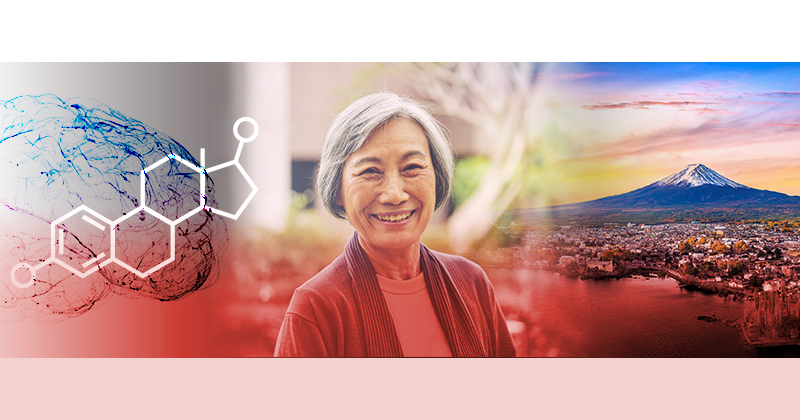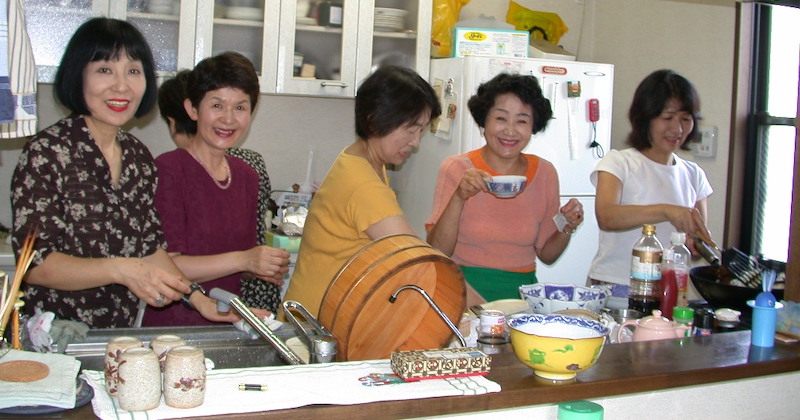


Menopause myths, debunked
Photo illustration by Jeffrey C. Chase | Portrait by Joe Center | Photo courtesy of Melissa Melby October 16, 2025
UD research sheds new insights on a hot topic
In Japan, women experience fewer menopausal symptoms, take less hormone replacement therapy and report smoother transitions into older age than their Western counterparts. The difference isn't genetic — it's cultural, linguistic and medical, according to UD anthropology professor Melissa Melby, who has spent almost three decades studying the topic.

Melby began researching menopause in Japan in her late 20s. Now, at age 53, she has published her first book on the understudied and frequently misunderstood life stage.
Reframing Aging: Insights from Biology and Culture of Midlife Japanese offers a collection of her work over the decades, challenging dominant Western narratives about hormones, aging and women’s health.
“The Japanese perspective might provide a counterbalance,” said Melby. “We tend to be reductionistic and simplistic, but there’s a lot more going on.”
Here, the medical anthropologist shares — and debunks — popular misconceptions that limit our understanding of the biological, cultural and physiological complexities at play.
Myth #1: The words we use don’t matter
Consider the difference between menopause (the stopping of menses; the end of reproduction) and kōnenki, a Japanese term that loosely translates to “a season of renewal.”
Melby calls language “a powerful two-way street,” not just reflecting experience, but influencing expectations.
“In the West, we talk about a decline — a loss of estrogen, the decline of hormones,” she said. “The Japanese view kōnenki as an adjustment period, much like puberty or pregnancy. That might explain, to some extent, why it’s less bothersome.”
Melby also found greater cultural acceptance and appreciation for aging in the East. With their children grown, many Japanese women took on new hobbies, careers and spiritual journeys.
This cultural difference even extends to medical questionnaires. When Melby examined Western literature, she noticed that very few menopausal symptom checklists (“almost none”) included positive changes like new interests, increased confidence or personal growth.
“What a surprise,” she said, half joking. “We only report on negative things because that’s all we ask about.”
Myth #2: Everyone experiences hot flashes the same way
When Melby first went to Japan in 1999 to study the effects of soy on menopause, she assumed she’d simply ask women about hot flashes. “That was pretty naïve,” she admits.
As anthropologist Margaret Lock had already discovered, the Japanese had three different terms for three distinct sensations: kyū na nekkan (a sudden feeling of heat in the face), hoteri (feeling hot or flushed) and nobose (rush of blood to the head, often described as dizzy and woozy). Melby’s research demonstrated how those terms were used to describe different temporal, physical and psychological attributes of hot flashes.
Again, she explains, language impacts experience: “In the West, our single word for hot flash might underestimate the amount of variation in the phenomenon.”

Myth #3: Symptoms are unique to women
While in Japan, Melby conducted a study to distinguish between aging and menopause. She gave men and women the same symptom checklist, deliberately including a wide range of experiences to hide her true research focus: “I didn't want anyone to know I was studying menopause.”
The results were striking. Only three symptoms were significantly different between sexes: stress, irritability and nervousness. All were higher in men. Hot flashes, night sweats and depression? None showed any significant difference.
“I see increasing numbers of doctors and women who think any issue they have is menopausal,” said Melby. “My small study says, ‘Look, even men are having these!’”
The inability to distinguish between normal aging and menopause-specific changes is “a real blind spot,” according to Melby. “Attributing everything to menopause may lead to unnecessary fear and medicalization of a phenomenon that is inherently natural. Worse, the confusion may mask other underlying conditions that might otherwise go untreated.”
Myth #4: If it’s not hot, it’s not menopause
In Japan, chilliness and shoulder stiffness tend to be prominent features of kōnenki. But when Melby pitched the idea of chilliness as a vasomotor symptom to a medical journal, the editors and reviewers rejected it for “not being a menopausal symptom.”
“I said, ‘It is a symptom in Japan. It correlates with hormonal changes and other vasomotor symptoms. Just because it’s not talked about in the U.S. doesn’t mean it’s not a symptom.’”
Melby’s paper was eventually published, and while giving a talk, a woman from Finland approached Melby afterward to share that she, too, experienced chilliness but had never heard it in the context of menopause before.
The incident highlights a critical gap in menopause research: Western medicine has largely defined what “counts” as a symptom based on limited cultural perspectives. “We don't have enough data to give women and their providers the information they need,” said Melby.
Myth #5: It all comes down to estrogen
In what researchers call Western, Educated, Industrialized, Rich and Democratic (WEIRD) societies like the United States, Melby has noticed a hyperfocus on estrogen levels.
Yes, estrogen declines. But progesterone declines too, while reproductive hormones like FSH (follicle-stimulating hormone) and LH (luteinizing hormone) increase. The feedback loops between the hypothalamus, pituitary and ovaries seem to get more unbalanced and less responsive. “There are many changes at many levels in the body, but we tend to focus on estrogen,” said Melby.
Meanwhile, in Japan, kōnenki was viewed as the product of an autonomic nervous system imbalance — the system that controls automatic bodily functions like breathing, heart rate, blood pressure, sex drive and digestion. “Things that are not conscious and fairly responsive to stress,” Melby explained.
After the perimenopausal transition (the years leading up to menopause when hormones fluctuate), hormones do stabilize, she adds. “FSH and LH don't increase forever, and estrogen doesn't decline forever.”
Melby’s research reveals that menopause is far more complex — and far more variable — than Western medicine has traditionally acknowledged. Cultural context, language, stress levels and autonomic nervous system function all play significant roles alongside hormonal changes.
“There will always be women on the extremes, some with no problems at all, some for whom menopause is debilitating,” she said. “But there are a lot of people in the middle for whom it's just one transition among many.”
Contact Us
Have a UDaily story idea?
Contact us at ocm@udel.edu
Members of the press
Contact us at mediarelations@udel.edu or visit the Media Relations website

